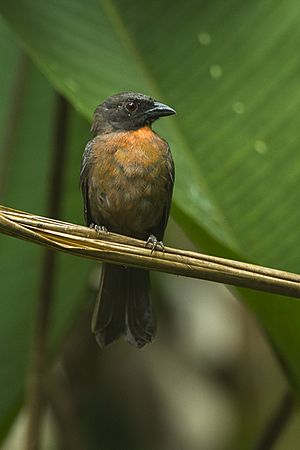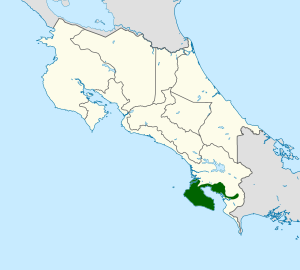Black-cheeked ant tanager facts for kids
Quick facts for kids Black-cheeked ant tanager |
|
|---|---|
 |
|
| Conservation status | |
| Scientific classification | |
| Genus: |
Habia (bird)
|
| Species: |
atrimaxillaris
|
 |
|
The black-cheeked ant tanager (Habia atrimaxillaris) is a special kind of bird. It belongs to the Cardinalidae family, which includes cardinals. This bird lives only in Costa Rica. It is found in a small area there.
Contents
About the Black-Cheeked Ant Tanager
How Scientists Classify This Bird
When the black-cheeked ant tanager was first discovered, scientists gave it the name Phoenicothraupis atrimaxillaris. They thought it was part of the Thraupidae family, known as "true" tanagers.
Later, scientists found that the group of birds called Habia was more important. So, the bird's name was changed to Habia atrimaxillaris.
In the early 2000s, new studies looked at the birds' DNA. These studies showed that all Habia birds were actually more closely related to cardinals. Because of this, they were moved to the Cardinalidae family.
What This Bird Looks Like
The black-cheeked ant tanager is about 18 to 19 centimeters (7 to 7.5 inches) long. It weighs between 36 and 49 grams (1.3 to 1.7 ounces).
Male birds have dark gray feathers on their upper bodies. These feathers have a hint of red. They also have a crest on their head that is orange-red, but it is usually hidden. Their face has a dark, blurry "mask" that looks black. The throat is a bright salmon orange color. This color fades to a darker salmon and then to a dark gray on the belly. The belly feathers have a pinkish tint.
Female birds look similar to males but are not as brightly colored. Their crest is also smaller.
Where This Bird Lives
The black-cheeked ant tanager is found only in Costa Rica. It lives on the Osa Peninsula and the nearby eastern shore of Golfo Dulce.
One bird was once found far inland, about 70 kilometers (43 miles) from its usual home.
These birds like to live in thick understory plants in lowland forests. They also live near rivers and in older secondary forests. They prefer to stay deep inside the forest. They do not like open areas or the edges of forests. They usually live at elevations up to about 300 meters (980 feet) high.
How the Black-Cheeked Ant Tanager Behaves
What It Eats
The black-cheeked ant tanager mainly eats insects. It is an insectivorous bird. However, it also eats fruits and small animals with backbones.
How It Raises Its Young
Scientists have seen black-cheeked ant tanagers building nests between January and March. They build an open, cup-shaped nest. These nests are usually placed fairly low in the understory plants.
All the nests found so far have had two eggs. It seems that these birds might help each other raise their young. Scientists have seen three adult birds taking care of the baby birds in a nest.
The Sounds It Makes
The black-cheeked ant tanager has a special song it sings at dawn. Some people describe it as "whistled phrases" like chonk TWEEah, chonk TWEEah. Others say it sounds like a "clear, mellow, whistled tu-see, tu-see or tu-seeur tu-swee tu-seeur" [1].
It also makes different calls, like these sounds [2] and [3].
Protecting the Black-Cheeked Ant Tanager
The IUCN (International Union for Conservation of Nature) has listed the black-cheeked ant tanager as "near threatened." This means it could become endangered soon.
The main reason for this is its small living area. Most of its habitat is within two protected areas. The biggest threat to this bird is that its lowland forest home is being broken up into smaller pieces.
See also
 In Spanish: Piranga hormiguera de mejillas negras para niños
In Spanish: Piranga hormiguera de mejillas negras para niños


